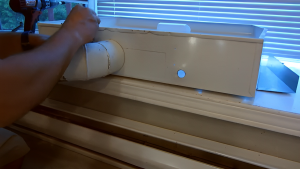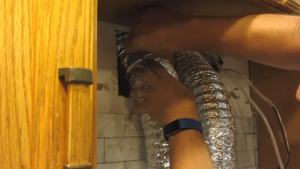How to Soundproof an Inline Fan: Useful Tips for Reducing Noise

What is an Inline Fan and Where you could meet them?
Inline fans are commonly used in a variety of settings, such as commercial buildings, factories, and residential homes. They can be found in places such as bathrooms, kitchens, laundry rooms, and basements, where there is a need for efficient air circulation and ventilation.
You can also find inline fans in HVAC (heating, ventilation, and air conditioning) systems, where they push or pull air through a ventilation or cooling system. So, they are often used to help distribute conditioned air throughout a building. They are generally connected to a vent or grille in order to draw air into the system when it is being used for ventilation. In the case of cooling systems, they use electricity and work by compressing and expanding air. Such fans are widely used in commercial buildings and houses. it has a lot of advantages but at the same time, there are some problems that may be caused by the inline fan.
Additionally, inline fans are used in grow rooms and indoor gardens, where they can help regulate temperature, humidity, and air quality.
The Causes of Inline Fan Noise
Inline fans are great in use but it is not a secret that they can be too noisy. The level of its noise depends on different factors such as type of fan, length of ducts, location, and so on.
Stat with using a dB meter to measure the noise level of a working inline fan. If it’s more than 75 dB you must start looking for problems in your inline fan system. They can be caused by non-proper installment or something may be wrong with part or all of your unit – it might need repairs or maintenance if it makes unusual sounds when it runs. Let’s check the common causes of your inline fan noise.
1. Inline Fan Speed Problem
The inline fan speed is one of the most common causes of noise. If it’s not set right, you may experience humming or rattling sounds coming from your air ducts because parts are vibrating against each other to produce that annoying sound.
Another case – if the motor turns faster than what it should be then probably you’re hearing a noise from your inline fan. You can try to change its speed or add a small piece of rubber between the blades and motor housing – it should be enough for reducing this kind of unpleasant humming sound.
2. Vortex Shedding of Inline Fan
It means that your fan is not balanced and it starts to vibrate at high rpm. It can also produce a loud noise or even cause damage to the whole unit. You must have this problem fixed immediately.
If you’re trying to fix the problem yourself, first check all screws holding blades together as well as those which keep them in place on the motor housing. Tighten everything if needed but do it carefully so you don’t break some parts of your inline fan system while doing this kind of repair work. Another thing that might be done by anyone is changing airflow direction from one side to another (it should be changed every time when correct balancing is done).
3. Inline Fan Load Problem
The inline fan load is another common cause of the noise. It occurs when the air pressure in your ventilation system is too high and it can be caused by wrong duct design, improper placement, or size of inline fans – especially if there is more than one unit working together on a single system. There’s nothing that you could do about this problem yourself so don’t waste your time with DIY tips! Always call professionals to solve such issues because they have special equipment for checking airflow, designing proper ducts, and installing everything correctly.
4. Inline Fan Structure Vibration
If the inline fan is not mounted properly it may start to vibrate and produce noise. This problem could be easily solved by balancing your unit or using rubber pads between parts that might cause an unpleasant humming sound in the working process. If nothing helps then you must check how strong and steady all screws and bolts holding different components together are, especially if they’re made of metal – such areas should never contact each other so use this trick for avoiding noisy fans. Don’t forget about proper installation when buying any kind of device for ventilation systems because structure vibration can also appear in case if there’s not enough space allowed inside ducts or around inline fans (make sure everything has its own place). Also, don’t hesitate to ask professionals what else can be done in case you’re not sure about something.
Sources Where Engineers Discuss Soundproofing Inline Fans
Soundproofing inline fans can be a tricky task for engineers, as reducing noise while maintaining proper airflow requires a delicate balance. However, there are numerous resources available online where engineers can discuss and share their experiences with soundproofing inline fans.
HVAC School – This website offers resources and training for HVAC technicians and engineers. They have a podcast episode titled “Soundproofing HVAC Systems” where they discuss the importance of soundproofing inline fans in commercial and residential buildings.
Engineering Toolbox – This site provides technical information and tools for engineers. They have a section on “Fan Noise” where they discuss the causes of noise in fans, including inline fans, and provide solutions to reduce noise levels.
Noise Control Engineering – This engineering firm specializes in noise control solutions for a range of industries. They offer services for reducing noise from HVAC systems, including inline fans, and provide case studies and whitepapers on the topic.
In addition to the sources previously listed, another valuable resource for engineers looking to soundproof their inline fans is the AVS Forum. This forum is dedicated to audio, video, and home theater discussions and has a section specifically for soundproofing and acoustics. Here, engineers can connect with other professionals and DIY enthusiasts to discuss the best methods and materials for achieving effective soundproofing for inline fans.
How to Soundproof Inline Fan?
If you want to soundproof your inline fan you can try the following tips. Let’s check them one by one.
Use the Cardboard to Isolate the Inline Fan
You can use thick cardboard for soundproofing your inline fan. It’s cheap and easy to cut, you just need large pieces of corrugated board that will fit inside the ventilation system (you may also cover the whole unit with it). Make sure there are no gaps between sheets – they should be attached firmly around metal parts by using duct tape or stapling them together.
It helps reducing noise in case if you put several layers of cardboards above the blades so vibrations have more places to go away from this area instead of staying in one place where they could cause unpleasant humming sounds when working properly. If possible, fill all other available spaces between parts and covers with these boards as well because the insulation is very important here. You won’t regret buying such a cheap tool to eliminate the noise.
Use Inline Fan Insulating Ducts

Inline fan insulating ducts are another cheap and easy-to-use solution for soundproofing your ventilation system. These special covers are made of thick plastic or metal with small holes in the surface and a cable running along their length. When using such an item, make sure there’s no gap between its end part and any other component that makes noise during operation. If needed cover everything with several layers of cardboard but only on one side so you can attach this tool easily without creating additional gaps inside vents.
This device allows reducing airflow noise because hot air will touch outer walls instead of moving through internal components of the inline fan – this will reduce vibration and eliminate possible humming sounds. As well as any other insulation material, in-ducting sound proofers also help with condensation problems because they’re able to keep strong airflow coming out from ventilation units away from cold surfaces that may cause water vapor freezing inside ducts.
Buy a Fan Speed Controller
The fan speed controller is a speed controller that allows changing the device’s rotational speed by adjusting voltage up or down. If you have an older ventilation system with one big motor, this could be exactly what you need to reduce noise because it can help to slow down blades rotating and make them less noisy.
Use Neoprene Duct Clamps to Join the Fan and Filter or Silencer
Neoprene duct clamps are another type of insulation that can be used to reduce inline fan noise by attaching the components together. They’re able to hold several parts tightly so there’ll be no gaps between them and vibration won’t escape through these cracks.
Inline fans might cause a lot of issues because they usually have big blades which turn really fast when working properly – this process is relatively loud unless you add some other elements like reducing paddles or turning down voltage, but sometimes even this may not help if your unit doesn’t perform well enough (the usual problem with cheap models). A clamp could solve all problems in most cases because it reduces airflow turbulence along its length and makes vibrations travel away from critical areas where noises seem louder than usual.
Using a muffler and an acoustic enclosure – What is the difference?
The main difference between using a muffler or silencer and an acoustic enclosure for an inline fan is the level of noise reduction they provide and the cost involved.
A muffler or silencer is a relatively cheap option that helps to reduce noise by using sound-absorbing materials such as foam or rubber to absorb unwanted sound waves. It is a container that is usually made of thick metal and has multiple layers of insulation to prevent hot airflow from touching the outer walls. The muffler/silencer reduces any unwanted whistling sounds caused by high-speed air movement through vents. However, plastic models are not recommended since they do not work well enough when creating strong pressure inside ventilation systems.
On the other hand, an acoustic enclosure is a more expensive option that is specifically designed for a particular ventilation unit. It is made of multiple thick insulation layers and has several holes on its surface and internal panels covered with soundproofing layers to absorb any airflow turbulence created during operation. This prevents vibration from leaving the device via vents, resulting in no whistling sounds at high speeds. The acoustic enclosure is usually attached directly to the unit or used as part of a silent box with thick foam inside or a muffler/silencer box. While it is more expensive, it provides a more effective solution to reduce inline fan noise, resulting in strong airflow leaving the ventilation unit silently.
In summary, the muffler/silencer is a cheaper option that reduces noise to a certain extent, while an acoustic enclosure is a more expensive option that provides a more effective solution to reduce noise for a specific ventilation unit.
Invest in a Quiet Inline Fan
If you’re tired of dealing with loud noises, you should think about getting a quiet inline fan. These fans are made specifically to operate with low noise. They have blades that are rounded at the end and rotate slowly like propellers, which reduces turbulence in the ventilation system. This means no more whistling or humming noises, even if your internals aren’t the best quality. You can also reduce any noise that escapes through the ducts by using an insulated box made of thick layers of insulation materials.
However, keep in mind that each model has its own power usage ratio. They usually require more energy to create strong pressure but don’t have powerful motors compared to standard inline fans. If you don’t mind spending a bit more money for energy and noise reduction, go for an expensive quiet model – it’s worth it! Alternatively, you can also look up DIY advice on YouTube and other sources to try and fix the problem on your own.



